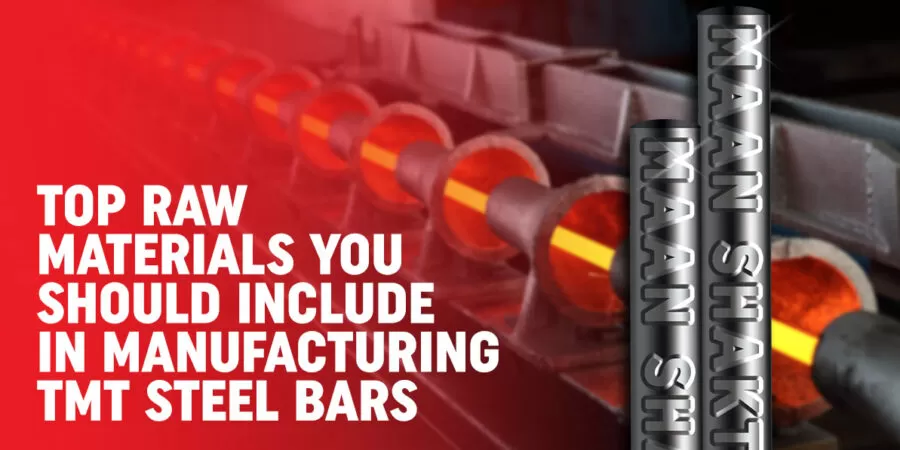The concept of TMT bars became popular with Ernest Becker’s Pulitzer Prize-winning work of nonfiction – The Denial of Death. This 1973 book gave the construction world a hint of what the future might look like. Then came the evolution of 1979, when TMT bars were introduced in the construction industry. India witnessed its advent between 1980 and 1985 when most Indian steel companies dealt with Fe 500 and Fe 550 bars.
In the modern universe, TMT bars are a quintessential component in the construction domain. They are used in most constructions. These bars are special because they undergo a set of procedures that determine their strength and flexibility.
Quality TMT bars depend on a few parameters, such as the material property and equipment used. So, what are these raw materials? That gives rise to the discussion of this post. Let’s discover them one by one in the following narrative.
Iron Ore
Iron ores are the most important raw materials used in manufacturing TMT steel. They have a special quality that makes TMT rods strong. Iron ores are used in a certain process to manufacture these bars. First, they are placed in the furnace, where they undergo a special gas treatment. In this stage, they remain in a liquid form.
The molten iron gets pre-processed into steel when the liquid interacts with the hot gas. After this, a casting machine is used to pour the liquid form. Once the liquid iron is poured into the furnace, it combines with other raw materials (coal and limestone) for heating. Interaction with coal and limestone strengthens the iron, and that’s how premium quality iron is produced. ‘
Dolomite
Using fluxing materials in the manufacturing process of iron ores results in strong, high-quality, and pure TMT bars. Dolomite is one of the fluxes used. It is poured into the furnace process alongside other raw materials. Note that the steel industry uses dolomite alongside 1% silica.
Adding dolomite to the mixture in the furnace process removes impurities such as sulphur and phosphorus from molten steel. It’s a refractory material that helps make slags. In addition, it also makes the melting process faster.
Since dolomite has a higher melting point, it reacts with impurities to form slag. The slag then floats on the surface of the molten steel and removes impurities accordingly. Calcined dolomite further improves the lining life of the oxygen furnace. Combining it with liquid slag (leftover ones) further improves the refractory properties.
Coal and Coke
The next raw materials used together in the conversion process are coke and coal. Combined with dolomite and iron ore, coke and coal can achieve the best proportion of these bars. Simply put, coke has a dual role in steelmaking. While it offers the heat required for melting the ore, it also burns itself and collects oxygen from the iron ore. As a result, it leaves pure iron. In fact, coal is also heated in oxygen’s absence.
Limestone
The extraction of limestone is a significant process. However, rather than conducting the process in underground mines, it is conducted in open-air quarries. The extracting process is then done by blasting, crushing, and screening. Again, limestone is another important fluxing material used for making top-quality TMT bars. Used as a slag former, it improves performance.
Micro-Alloying Materials
Certain micro-alloying materials are used to manufacture TMT bars. They are mentioned below:
Boron
Boron improves the cooling process of TMT bars, helping them achieve malleable and bendable properties. It’s also why iron bars have a hardened structure.
Vanadium
Vanadium is an alloying element that combines carbide compounds and improves the overall quality. It makes the TMT bars wear-resistant.
Niobium
The next micro-alloying element is niobium, which is responsible for refining its grain structure. TMT bars achieve tough and weldable properties due to this material. Niobium also improves the structural integrity of these bars.
Titanium
Titanium and niobium have similar properties. Titanium helps refine and detoxify grains. Since it promotes a uniform microstructure, TMT bars achieve a ductile quality. Because of this micro-alloying element, TMT bars can withstand external stress.
Zirconium
Zirconium is another significant component used in heating as it can control grain size. It improves the bars ‘ durability since it gives the structure a fine-tuning shape. So, zirconium is the reason behind the popularity of TMT bars as a material suitable for different construction purposes.
Cerium and Lanthanum
These are rare-earth metals that refine the grain. They clean the steel and eliminate impurities. In addition, they increase the bars’ mechanical properties. So, these micro-alloying elements improve the bars’ strength, durability, and performance.
Molybdenum
This material gives the bars further strength and makes them highly corrosion-resistant, forming hard carbides to improve their strength. Do you know why TMT bars are highly resistant to environmental conditions that may create corrosion? You guessed it right—molybdenum is the reason.
Wrapping up
So, when you decide to consult the manufacturer of TMT bars for wholesale purposes, never forget to learn how they are created. Ask the manufacturer about the raw materials used in constructing these bars. Only then will you understand whether the selected bars are of premium quality.


Leave a Reply